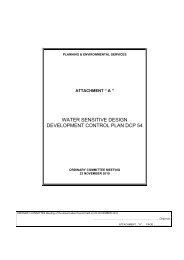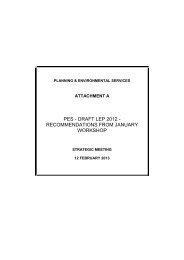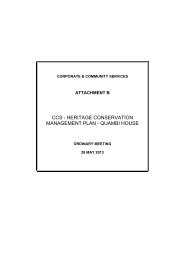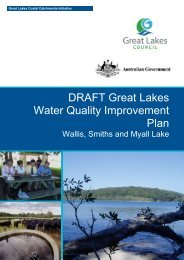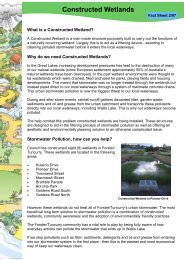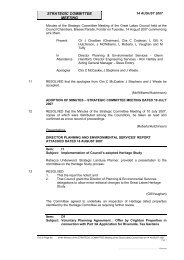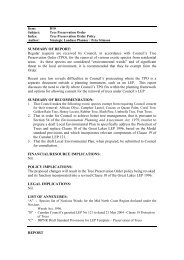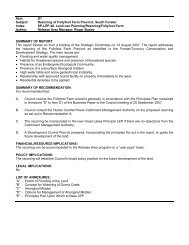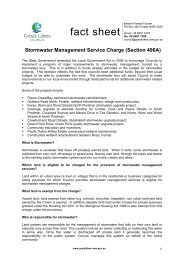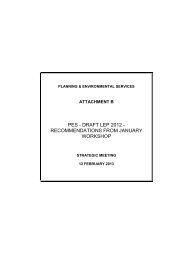smiths lake planning study volume 1: text - Great Lakes Council
smiths lake planning study volume 1: text - Great Lakes Council
smiths lake planning study volume 1: text - Great Lakes Council
You also want an ePaper? Increase the reach of your titles
YUMPU automatically turns print PDFs into web optimized ePapers that Google loves.
SOILS AND GEOTECHNICAL 24<br />
2.6.3 Erosion<br />
The soils of the SLVA have a moderate to high erodibility and are prone to sheet and scour<br />
erosion once disturbed. Development should be undertaken in accordance with Department of<br />
Land and Water Conservation guidelines. The following guidelines can be adopted in <strong>planning</strong><br />
and development to minimise the impact of erosion and sedimentation:<br />
• Investigate site features to ensure that land capability and the proposed development are<br />
compatible.<br />
• Undertake development in accordance with an erosion and sediment control plan.<br />
• Undertake erosion control involving managing runoff at a non- erosive velocity, controlling<br />
runoff onto, through and from the site, minimising the duration and area of soil exposed<br />
during earthworks and providing protection for the soil surface.<br />
• Undertake sediment control involving trapping and containing soil particles that have been<br />
eroded.<br />
• Undertake rehabilitation and re-vegetation of disturbed areas within 14 days of completion<br />
of earthworks. Re-use topsoil.<br />
• Maintain erosion and sediment control measures.<br />
2.6.4 Acid Sulphate Soils<br />
Acid sulphate soil investigation should be undertaken for all developments proposed in the<br />
medium and high risk areas as shown on Figure 2-2. This includes all activities where soils are<br />
to be excavated or disturbed (roadworks, foundations, drains etc) and where groundwater levels<br />
may be lowered (drains, groundwater extraction etc). Investigation should comprise a detailed<br />
soil survey with analytical data on the sulfide content down the profile. The acid producing<br />
potential of the soil needs to be quantified and evaluated in the con<strong>text</strong> of the local<br />
environment.<br />
Where areas of acid sulphate soil are quantified (analytical results exceed the action criteria<br />
outlined in Table 2-7), options are to avoid the area / site identified or undertake development<br />
in accordance with an Acid Sulphate Management Plan. The plan should provide a framework<br />
for the on going management and monitoring of the impacts throughout construction and<br />
operation of any project. The plan should comprise the following:<br />
• A summary of the soil and groundwater conditions.<br />
• Discussion of construction activities likely to impact on ASS.<br />
• The expected degree of impact of construction activities.<br />
• Control and management of construction activities to minimise impact.<br />
• Monitoring requirements to assess impacts.<br />
• Contingencies should monitoring demonstrate the occurrence of significant impact.<br />
SMITHS_LAKE_PLANNING_STUDY.DOC<br />
O C E A N I C S<br />
A U S T R A L I A




